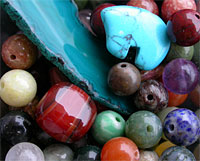|
A Short History of Beads
 By 2300 BC clay, stone and metal beads were traded all over the known world. Decorative items, such as shells from the ocean, were brought 500km inland for trading. By 2300 BC clay, stone and metal beads were traded all over the known world. Decorative items, such as shells from the ocean, were brought 500km inland for trading.
These kinds of paeolothic finds in India helped determine trade routes in the beginning. We can just imagine what an impact a shell on a string had, when it was first taken upcountry and put on the neck of a village head man! Not much short of magic! Snake vertebrae, animal teeth and rather finely carved stone amulets were all worn for decoration and protection. The carvings included fertility symbols, or Mother Earth, pictured as a Rubensque woman, protector of all life on earth.
In this time Egyptians were trading with their Mediterranean neighbours sending trading missions to the legendary land of Kus, in the present day Sudan. It is thought that by 2500 BC the Egyptians had established trade routes as far as China, as some of the grave finds include fragments of silk! The first glass beads were made in the Caucasus around 2400BC and were soon traded in the Middle East. These beads were made to imitate precious stones, such as lapis lazuli, rubies and emeralds.
In the time of the Old Kingdom, 2200 BC, bead making was in full swing in Egypt. Sophisticated metal work from Crete, lapis lazuli from the mount of Sinai and ivory from Kus and luxuries of all kinds were traded, and often paid for in beads. Egyptian clay beads, or mummy beads, were placed in graves in jars and the mummified bodies were decorated with them. Beads were put in the wrappings during mummification, often in the form of a Scarab, a holy beetle, symbol of Ammon. These beads told the masters in the afterworld who the deceased was, and secured that after returning from the world of Osiris, the Ka, or soul, could recognise which mummy was his, and become reborn. It was very important that the mummy was well preserved and clearly identifiable, and the beads helped do just this.
|